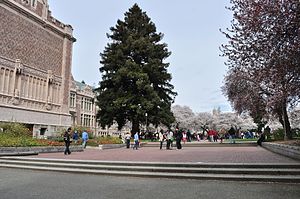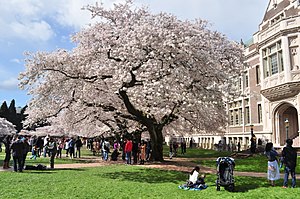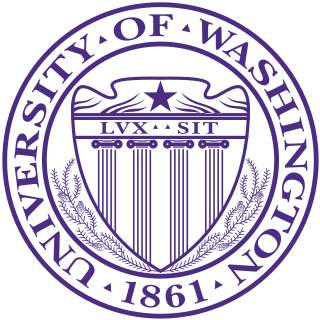
The University of Washington is a public research university in Seattle, Washington, United States. Founded in 1861, the University of Washington is one of the oldest universities on the West Coast of the United States.

Washington State University is a public land-grant research university in Pullman, Washington. Founded in 1890, WSU is also one of the oldest land-grant universities in the American West. With an undergraduate enrollment of 24,278 and a total enrollment of 28,581, it is the second largest institution for higher education in Washington state behind the University of Washington. It is classified among "R1: Doctoral Universities – Very high research activity".

The University of Wisconsin–Milwaukee is a public urban research university in Milwaukee, Wisconsin. It is the largest university in the Milwaukee metropolitan area and a member of the University of Wisconsin System. It is also one of the two doctoral degree-granting research universities and the second largest university in Wisconsin.
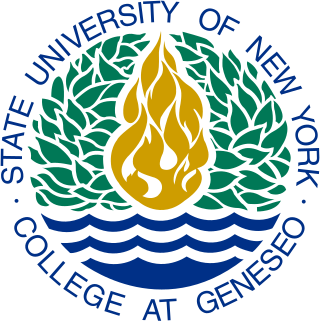
The State University of New York College at Geneseo is a public liberal arts college in Geneseo, New York. It is New York's public honors college and part of the State University of New York (SUNY) system. The college was founded in 1867 as the Wadsworth Normal and Training School before it became part of the new State University of New York system as a state liberal arts college in 1948.

Suzzallo Library is the central library of the University of Washington in Seattle, and perhaps the most recognizable building on campus. It is named for Henry Suzzallo, who was president of the University of Washington until he stepped down in 1926, the same year the first phase of the library's construction was completed. The library was renamed for him after his death in 1933.
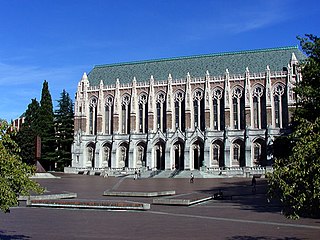
Red Square, officially Central Plaza, is a large open square on the Seattle campus of the University of Washington that serves as a hub for two of the university's major axes, connecting the campus's northern Liberal Arts Quadrangle with the science and engineering buildings found on the lower campus. The plaza is paved with red brick, and becomes notoriously slippery during rain.

The University of Wisconsin–Stevens Point is a public university in Stevens Point, Wisconsin. Established in 1894, it is part of the University of Wisconsin System. UW-Stevens Point grants associate, baccalaureate, and master's degrees, as well as doctoral degrees in audiology, educational sustainability, and physical therapy. The 406-acre (164 ha) main campus includes the 280-acre (113 ha) Schmeeckle Reserve, 15 academic buildings, and 13 residence halls. UWSP also has two branch campuses located in Wausau and Marshfield.
University of Nevada, Reno Arboretum is a state arboretum located across the campus at the University of Nevada, Reno in Reno, Nevada.

Meany Hall has been the name of two buildings on the University of Washington campus in Seattle. The current Meany Hall is considered one of the region's premier performance facilities, highly acclaimed by artists and audience members alike for its outstanding acoustics and intimate ambiance. Individual performance venues include the 1,206-seat proscenium Katharyn Alvord Gerlich Theater, and the 238-seat Meany Studio Theatre.

The University of Washington School of Law is the law school of the University of Washington, located on the northwest corner of the main campus in Seattle, Washington. The school is fully accredited by the American Bar Association and has been a member of the Association of American Law Schools since 1909.

In architecture, a quadrangle is a space or a courtyard, usually rectangular in plan, the sides of which are entirely or mainly occupied by parts of a large building. The word is probably most closely associated with college or university campus architecture, but quadrangles are also found in other buildings such as palaces. Most quadrangles are open-air, though a few have been roofed over, to provide additional space for social meeting areas or coffee shops for students.

The University of Wisconsin–Stevens Point at Marshfield, is a satellite campus of the University of Wisconsin–Stevens Point located in Marshfield, Wisconsin, USA.

The Quad is an approximately 22-acre (8.9 ha) quadrangle on the campus of the University of Alabama located in Tuscaloosa, Alabama. Home to most of the university's original buildings, this portion of the campus remains the geographic and historic center of the modern campus. Originally designed by architect William Nichols, construction of the university campus began in 1828, following the move of the Alabama state capital from Cahaba to Tuscaloosa in 1826. The overall design for this early version of the campus was patterned after Thomas Jefferson's plan for the University of Virginia, with its Lawn and Rotunda. Following the destruction of the campus during the American Civil War, a new Quad emerged in the late 19th and early 20th centuries. Different in form and function from the original design of the early 19th century, the modern Quad continues to fill its role as the heart of the campus. Although surrounded by academic and administrative buildings, only five structures are built directly on the Quad: the Little Round House, Tuomey Hall, Oliver-Barnard Hall, Amelia Gayle Gorgas Library, and Denny Chimes. The remainder of the space is occupied by a grove of trees on the west side and a great lawn on the east. A feature on the northwestern side, known as The Mound, is the site of the old Franklin Hall. A popular gathering place, the Quad is home to pep rallies, a bonfire during homecoming, and numerous day-to-day student activities.
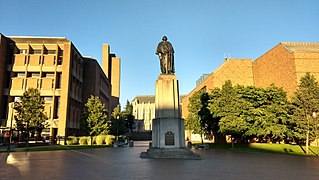
The Campus of the University of Washington is located in the University District of Seattle. Campus buildings are categorized by the major street or vicinity on which they are located on campus. In 2011, Slate magazine and Travel+Leisure described the Seattle campus as one of the most beautiful university campuses in the United States.

William H. Gates Hall is an academic building of the University of Washington in Seattle, Washington. William H. Gates Hall houses the University of Washington School of Law. The building is named after late William H. Gates, Sr., a lawyer who served as a partner of the Preston Gates & Ellis law firm. Gates was a 1950 graduate of the UW School of Law.
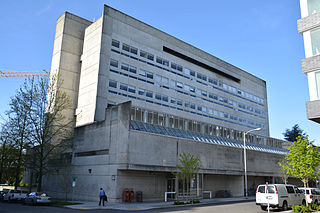
John T. Condon Hall is an academic building of the University of Washington in Seattle, Washington. The building formerly housed the UW School of Law. The hall was named after John T. Condon, the first dean of the School of Law.
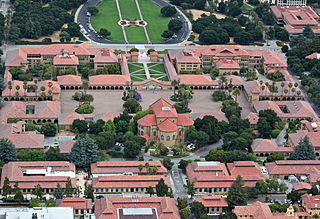
The Main Quadrangle, or more commonly Main Quad or simply Quad, is the heart and oldest part of Stanford University in California. The collection of connected buildings was started in 1887 and completed in 1906. The Quad was damaged in the 1906 San Francisco earthquake, repaired, less severely damaged in the 1989 Loma Prieta earthquake, and repaired again. The exteriors have remained almost the same since the beginning, though the interiors of most of the buildings have changed radically. The Main Quad is still used for its original purposes of teaching, research, and administration.

The Sylvan Grove Theater and Columns, also known as the Sylvan Grove Theater or simply the Sylvan Theater, is a sylvan theater located on the University of Washington campus in Seattle, Washington. Within the theater are four 24 foot (7.3 m) tall Ionic columns from the original University building downtown, constructed in 1861. They are some of the oldest-standing architectural pieces in Seattle. It has been called "one of the most beautiful places on campus."

The University of Washington College of Education is the school of education of the University of Washington. The College of Education offers both undergraduate and graduate degrees.
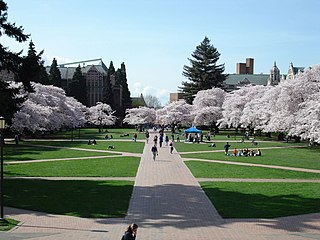
Cherry blossoms play an important role in the city of Seattle, in the U.S. state of Washington. Seattle has more than 1,000 cherry trees donated by Japan as a symbol of friendship. Christine Clarridge of Axios Seattle wrote, "The annual bloom of cherry trees across Seattle symbolizes the end of the dark months and the beginning of spring, drawing residents and swarms of tourists to the city's most popular viewing places." The season's peak varies depending on weather conditions, but generally lasts from January to March.





